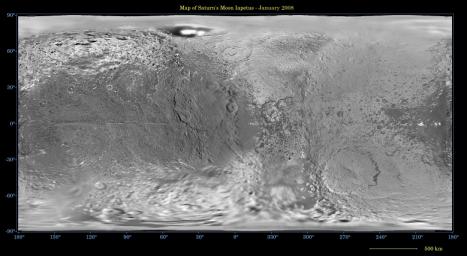
|
Map of Iapetus - January 2008
- Click the image above for a larger view
- Full-Res JPEG (7748 x 4250) (2.6 MB)
- Full-Res TIFF (7748 x 4250) (98.8 MB)
Caption:
This global map of Iapetus was created using images taken during Cassini spacecraft flybys, with Voyager images filling in the poles.
The map is an equidistant projection and has a scale of 803 meters (0.5 miles) per pixel. Some territory seen in this map was imaged by Cassini's cameras using reflected light from Saturn. The mean radius of Iapetus used for projection of this map is 736 kilometers (457 miles). The resolution of the map is 16 pixels per degree. This updated map has been shifted west by 4.5 degrees of longitude, compared to the previously released Cassini product (see PIA07778 ), in order to conform to the International Astronomical Union longitude system convention for Iapetus.
Background Info:
The Cassini-Huygens mission is a cooperative project of NASA, the European Space Agency and the Italian Space Agency. The Jet Propulsion Laboratory, a division of the California Institute of Technology in Pasadena, manages the mission for NASA's Science Mission Directorate, Washington, D.C. The Cassini orbiter and its two onboard cameras were designed, developed and assembled at JPL. The imaging operations center is based at the Space Science Institute in Boulder, Colo.
For more information about the Cassini-Huygens mission visit http://saturn.jpl.nasa.gov/home/index.cfm . The Cassini imaging team homepage is at http://ciclops.org .
Cataloging Keywords:
| Name | Value | Additional Values |
|---|---|---|
| Target | Iapetus | Saturn |
| System | Saturn | |
| Target Type | Satellite | Planet |
| Mission | Cassini-Huygens | Voyager |
| Instrument Host | Cassini Orbiter | |
| Host Type | Orbiter | Flyby Spacecraft |
| Instrument | Imaging Science Subsystem (ISS) | |
| Detector | ||
| Extra Keywords | Color, Map | |
| Acquisition Date | ||
| Release Date | 2008-01-31 | |
| Date in Caption | ||
| Image Credit | NASA/JPL/Space Science Institute | |
| Source | photojournal.jpl.nasa.gov/catalog/PIA08406 | |
| Identifier | PIA08406 | |
